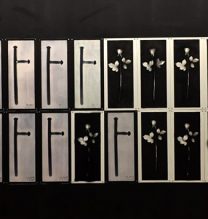Black Hand
Black Hand
A photogram is a photographic image made without a camera by placing objects directly onto the surface of a light-sensitive material such as photographic paper and then exposing it to light. The technique is sometimes called “Cameraless Photography”. Some of the first photographic images made were photograms. William Talbot called these “Photogenic Drawing”, which he made by placing leaves and pieces of material onto sensitized paper then left them outdoors on a sunny day to expose. This produced a dark background with a white silhouette of the object used. Photograms were used in the 20th century by some artists particularly Man Ray for artistic photography. He called them “Rayography”.
Blackography is an innovative technique based on integrating stencil technique and Rayography in which the stencil is used in an unconventional fashion. Objects are placed on a white canvas, on which black paint is vertically sprayed. The result will be an image that is made of negative and positive, or high-contrast, bright and dark patterns. In the final Blackograph print, the places on which the objects were put will be bright (white) on the canvas, while the negative parts will be dark (black). Therefore, the images are created by the unexpected effect (depending on the pressure applied on the spray’s cylinder) and the stark contrast of black and white.







